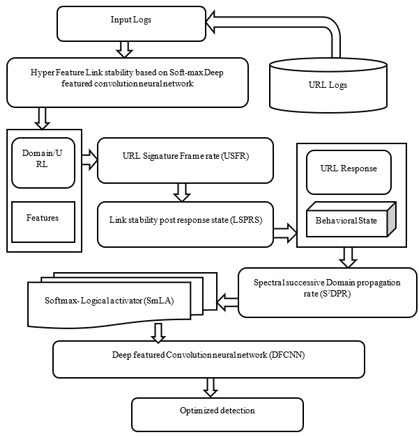Malicious URL Website Detection using Selective Hyper Feature Link Stability based on Soft-Max Deep Featured Convolution Neural Network
Main Article Content
Abstract
The web resource contains many domains with different users' Uniform Resource Locators (URLs). Due to the increasing amount of information on the Internet resource, malicious activities are done by hackers by expecting malicious websites in URL sub-links. Increasing information theft leads data sources to be vested in huge mediums. So, to analyze the web features to find the malicious webpage based on the deep learning approach, we propose a Selective Hyper Feature Link stability rate (SHFLSR) based on Soft-max Deep featured convolution neural network (SmDFCNN) for identifying the malicious website detection depends on the actions performed and its feature responses. Initially, the URL Signature Frame rate (USFR) is estimated to verify the domain-specific hosting. Then the link stability was confirmed by post-response rate using HyperLink stability post-response state (LSPRS). Depending upon the Spectral successive Domain propagation rate (S2DPR), the features were selected and trained with a deep neural classifier with a logically defined Softmax- Logical activator (SmLA) using Deep featured Convolution neural network (DFCNN). The proposed system performs a high-performance rate by detecting the malicious URL based on the behavioral response of the domain. It increases the detection rate, prediction rate, and classifier performance.
Article Details
References
J. Clayton and K. Bishal, “Towards detecting and classifying malicious URL using deep learning," Journal of Wireless Mobile Networks, Ubiquitous Computing, and Dependable Applications (JoWUA), vol. 11, no. 4, pp. 31–48, 2020
H. Lin, S. Cao, J. Wu, Z. Cao, and F. Wang, "Identifying Application-Layer DDoS Attacks Based on Request Rhythm Matrices," in IEEE Access, vol. 7, pp. 164480-164491, 2019, doi: 10.1109/ACCESS.2019.2950820.
R. B. Basnet and R. Shash, “Towards detecting and classifying network intrusion traffic using deep learning frameworks,” Journal of Internet Services and Information Security, vol. 9, no. 4, pp. 1–17, 2019.
Y. Qin, W. Wang, S. Zhang and K. Chen, "An Exploit Kits Detection Approach Based on HTTP Message Graph," in IEEE Transactions on Information Forensics and Security, vol. 16, pp. 3387-3400, 2021, doi: 10.1109/TIFS.2021.3080082.
T. Li, C. Ren, Y. Fu, J. Xu, J. Guo and X. Chen, "Webshell Detection Based on the Word Attention Mechanism," in IEEE Access, vol. 7, pp. 185140-185147, 2019, doi: 10.1109/ACCESS.2019.2959950.
Z. Feng, C. Shuo, and W. Xiaochuan, “Classification for DGA-based malicious domain names with deep learning architectures,” in Proceedings of the Second International Conference on Applied Mathematics and information technology, p. 5, Shanghai, China, October 2017.
X. Liu and J. Fu, "SPWalk: Similar Property Oriented Feature Learning for Phishing Detection," in IEEE Access, vol. 8, pp. 87031-87045, 2020, doi: 10.1109/ACCESS.2020.2992381.
C. Choudhary, R. Sivaguru, M. Pereira, B. Yu, A. Nascimento, and M. De Cock, “Algorithmically generated domain detection and malware family classification,” in Proceedings of the International Symposium on Security in Computing and Communication, pp. 640–655, Springer, Singapore, September 2018.
I. Vaccari, S. Narteni, M. Aiello, M. Mongelli and E. Cambiaso, "Exploiting Internet of Things Protocols for Malicious Data Exfiltration Activities," in IEEE Access, vol. 9, pp. 104261-104280, 2021, doi: 10.1109/ACCESS.2021.3099642.
X. Ruan, Z. Wu, H. Wang and S. Jajodia, "Profiling Online Social Behaviors for Compromised Account Detection," in IEEE Transactions on Information Forensics and Security, vol. 11, no. 1, pp. 176-187, Jan. 2016, doi: 10.1109/TIFS.2015.2482465.
C. Amrutkar, Y. S. Kim and P. Traynor, "Detecting Mobile Malicious Webpages in Real Time," in IEEE Transactions on Mobile Computing, vol. 16, no. 8, pp. 2184-2197, 1 Aug. 2017, doi: 10.1109/TMC.2016.2575828.
T. Shibahara, K. Yamanishi, and Y. Takata, “Malicious URL sequence detection using event de-noising convolutional neural network,” in Proceeings of the Communications (ICC), 2017 IEEE International Conference, pp. 1–7, IEEE, Paris, France, May 2017.
J. C. Prieto, A. Fernández-Isabel, I. M. De Diego, F. Ortega and J. M. Moguerza, "Knowledge-Based Approach to Detect Potentially Risky Websites," in IEEE Access, vol. 9, pp. 11633-11643, 2021, doi: 10.1109/ACCESS.2021.3051374.
D. R. Patil and J. B. Patil, “Survey on malicious web pages detection techniques,” International Journal of U- and E-Service, Science and Technology, vol. 8, no. 5, pp. 195–206, 2015.
C. Xu, J. Shen, and X. Du, “Detection method of domain names generated by DGAs based on semantic representation and deep neural network,” Computers & Security, vol. 85, pp. 77–88, 2019.
R. -H. Hwang, M. -C. Peng, C. -W. Huang, P. -C. Lin and V. -L. Nguyen, "An Unsupervised Deep Learning Model for Early Network Traffic Anomaly Detection," in IEEE Access, vol. 8, pp. 30387-30399, 2020, doi: 10.1109/ACCESS.2020.2973023.
Srinivasan, Sriram& Ravi, Vinayakumar&Arunachalam, Ajay &Alazab, Mamoun&Kp, Soman. (2021). DURLD: Malicious URL Detection Using Deep Learning-Based Character Level Representations. 10.1007/978-3-030-62582-5_21.
D. Lazar, K. Cohen, A. Freund, A. Bartik and A. Ron, "IMDoC: Identification of Malicious Domain Campaigns via DNS and Communicating Files," in IEEE Access, vol. 9, pp. 45242-45258, 2021, doi: 10.1109/ACCESS.2021.3066957.
X. Yan, Y. Xu, B. Cui, S. Zhang, T. Guo and C. Li, "Learning URL Embedding for Malicious Website Detection," in IEEE Transactions on Industrial Informatics, vol. 16, no. 10, pp. 6673-6681, Oct. 2020, doi: 10.1109/TII.2020.2977886.
J. Yang, P. Yang, X. Jin, and Q. Ma, “Multi-classification for malicious URL based on improved semi-supervised algorithm,” in Proceedings of the IEEE International Conference on Computational Science and Engineering (CSE) and IEEE International Conference on Embedded and Ubiquitous Computing (EUC), pp. 143–150, IEEE, Guangzhou, China, July 2017.
D. Liu and J. -H. Lee, "CNN Based Malicious Website Detection by Invalidating Multiple Web Spams," in IEEE Access, vol. 8, pp. 97258-97266, 2020, doi: 10.1109/ACCESS.2020.2995157.
G. K., S. ., Reddy K. R., U. K. ., A. Rathod, J. ., B. P., S. ., & P. K., L. . (2023). Diabetic Retinopathy Prediction using Modified Inception V3 Model Structure. International Journal of Intelligent Systems and Applications in Engineering, 11(1), 261–268. Retrieved from https://ijisae.org/index.php/IJISAE/article/view/2466

